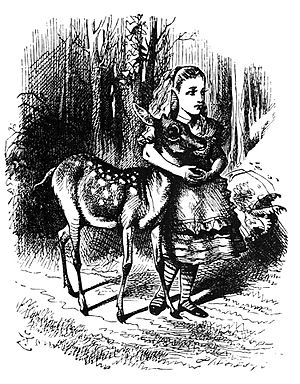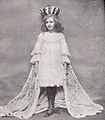Through the Looking-Glass facts for kids

Alice and the fawn
|
|
| Author | Lewis Carroll |
|---|---|
| Illustrator | John Tenniel |
| Country | United Kingdom |
| Language | English |
| Genre | Children's fiction |
| Publisher | Macmillan |
|
Publication date
|
1871 |
| Media type | Print (hardback) |
| Pages | 224 pp |
| Preceded by | Alice's Adventures in Wonderland |
Through the Looking-Glass, and What Alice Found There is a popular children's novel. It was written by Lewis Carroll and published in 1871. John Tenniel drew the famous pictures for the book. This story is a sequel to Alice's Adventures in Wonderland.
The book takes you on a dream-like adventure. Alice travels through a magical mirror, called a looking-glass. She finds herself in a strange world that looks like a giant chess game. Alice starts as a pawn and tries to become a queen.
Contents
Alice's Mirror Adventure
The story begins when Alice steps through a mirror above her fireplace. She enters a topsy-turvy world. In this world, everything is backwards, just like in a mirror. The setting for her journey is a big game of chess.
Alice meets many funny and unusual characters. These include Tweedledum and Tweedledee, the Walrus and the Carpenter, and the White Knight. She also finds a Garden of Live Flowers that can talk!
Meeting the White Queen
Alice meets the White Queen, who is very forgetful. The Queen often talks about things that will happen in the future. Alice and the White Queen move forward on the chessboard. They cross a stream together.
When they cross, the Queen changes into a talking Sheep. This Sheep runs a small shop. Alice tries to row a boat, but the Sheep shouts confusing things. It uses words like "crabs" and "feathers." Alice doesn't know these are real terms used in rowing. The Queen, as the Sheep, was actually making sense!
Famous Poems and Wordplay
Through the Looking-Glass is famous for its funny poems. These are often called "nonsense poems." Two well-known examples are Jabberwocky and The Walrus and the Carpenter.
The book also uses a lot of word play. This means playing with words to make jokes or new meanings. You'll find puns, which are jokes using words that sound alike. There are also many made-up words that sound real.
Images for kids
-
The Jabberwock
See also
 In Spanish: A través del espejo y lo que Alicia encontró allí para niños
In Spanish: A través del espejo y lo que Alicia encontró allí para niños




